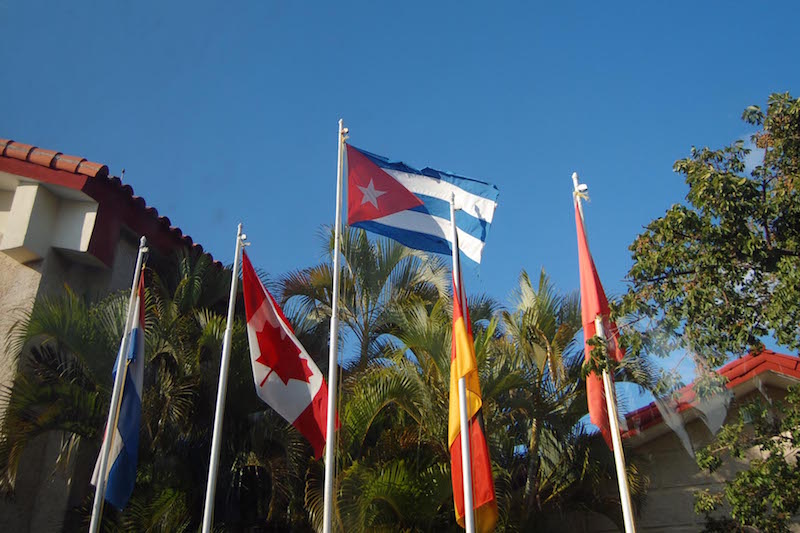Since late 2016, diplomats working in Havana began complaining of a set of symptoms: painful headaches, dizziness, and hearing loss were recorded on the diplomats’ medical reports, with some being diagnosed as suffering from mild traumatic brain injury and damage to their central nervous systems. The Cuban Foreign Ministry was made aware of the mysterious health conditions in February 2017, and an investigation was launched by the United States. The investigation did not lead to any perpetrators or provide definitive answers on the case. It was, however, speculated that the American government personnel, and some of their spouses, were targets of a sonic attack. As punitive damage for failing to protect diplomats as set out in the Vienna Convention, two accredited Cuban embassy officials were expelled by the US in late May 2017. Then in June, it was reported that a Canadian diplomat suffered from symptoms consistent with those of their American counterparts in Cuba. The Cuban government denied any involvement and Canada has not pursued any diplomatic retaliation, but has since instead joined the investigative efforts.
The mystery of the source of the symptoms is about as mysterious as its effects.
A sonic device sophisticated enough to induce the injuries observed in the diplomats would use sound wave frequencies that are beyond the hearing range of humans, but covertly cause physical distress to exposed individuals. This would help explain the symptoms experienced by the affected diplomats. Researchers from the UK tested the impact of undetectable low-frequency sounds by comparing two concert go-er groups. Neither group knew which one they belonged to; one group was exposed to infrasound while simultaneously listening to music, while the other listened to music absent of these low-frequencies. Comparing the experiences of the participants, the study found a correlation between feeling unwell while listening to music when low-frequencies were emitted versus none. The findings lend support to the idea that sound waves can unconsciously disrupt the body. In fact, sound waves can be weaponized.
Riot police make use of ultrasonic sound at audible ranges to disperse crowds during protests. The Israeli Defence Force used a sonic gun, called the Scream, that caused protestors to feel nauseous and dizzy by shooting pulses of high-frequency sound at them. The Thunder Generator is another sonic blaster that was developed by an Israeli firm, and detonates sound so loud, it becomes lethal.
Ultrasonic frequencies can also go undetected by human ears because they emit frequencies higher than in the normal hearing range. It is likely that in the case of the affected diplomats, a high-frequency device would have been used instead of a low one. That’s because with ultrasonic sounds, its frequencies can be focused at its targets, as opposed to being directed en masse like in low-frequency tones. But, using an emitter that is both ultrasonic and inaudible requires an advanced device.
An alternate explanation for the symptoms of the Canadian and US diplomats revolves around whether a virus might have been transmitted by an infected mosquito. Cuba’s subtropical geography means that a humid climate is favourable to mosquito reproduction. The two common viral infections spread in Cuba by mosquitos are chikungunya and dengue, while Zika has been contained. Headaches, nausea, and dizziness are common symptoms of these viruses, but Zika in particular has been associated with hearing and vision complications, possibly due to inflammation of the inner ear and retina. But wouldn’t the affected diplomats be tested for these diseases to rule them out as a cause? As the active investigation continues, all involved parties have been mum about their findings.
Naturally, the question of why exclusively Canadian and American diplomats would be targets of an acoustic attack is a relevant one. At least one Canadian and 16 Americans, including their spouses, have reported the same symptoms. When the homes of the diplomats were searched, nothing was found that confirmed a sonic attack. Eavesdropping on foreign counterparts is a common practice through methods like intercepting communications. So then, could it be possible that the explanation for Canadian and American diplomats becoming afflicted is the result of surveillance gone wrong? The timing of the complaints aligns with the end of the US trade embargo on Cuba in 2016, where Canada brokered diplomatic ties between the US and Cuba. Or is this ordeal the result of espionage efforts by a third party, in an effort to drive a wedge between the countries? With multiple theories to explain the incident, Canada, Cuba, and the US are cooperating together to ascertain the source of the symptoms. Insidious intent on behalf of Cuba to cause physical harm seems unlikely, but the situation could raise issue regarding the safety of diplomats abroad; and with that, resurrect feelings of secrecy and distrust as they relate to the practice of intelligence collection.
While the mystery saga continues, it appears as though science fiction is trickling down to reality.
Photo: “France Canada Cuba Germany China” (2010) by Carole via Flickr. Licensed under CC BY-NC-ND 2.0.
Disclaimer: Any views or opinions expressed in articles are solely those of the authors
and do not necessarily represent the views of the NATO Association of Canada.




